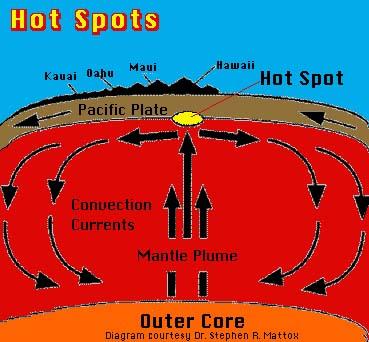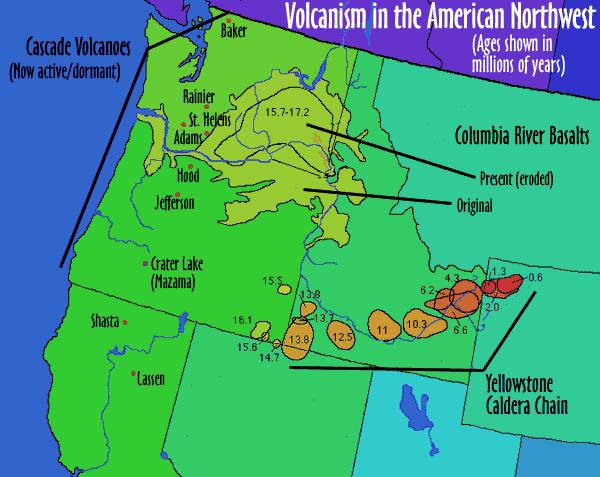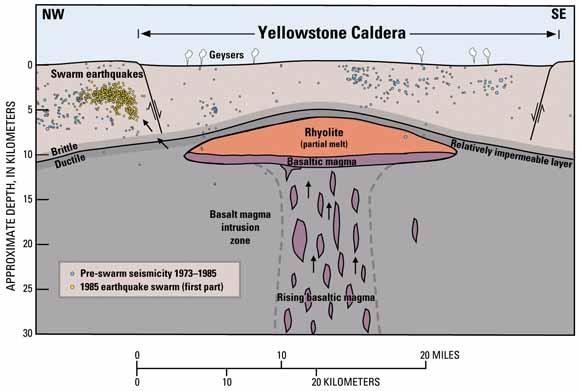
 This overlook is on the eastern edge of the Yellowstone Caldera (see Yellowstone Caldera at Madison Junction for a description of a caldera). Looking west, the other side of the rim is 30 miles away. One of the questions about Yellowstone is the question of the source of the volcanism at Yellowstone. There are many theories and as far as I know, the scientific community has agreed upon a single definitive explanation. However, one theory which is simple and has a lot of evidence in support of it, has become the most common explanation. This theory is the hot spot theory, just like the Hawaiian Volcano chain.
This overlook is on the eastern edge of the Yellowstone Caldera (see Yellowstone Caldera at Madison Junction for a description of a caldera). Looking west, the other side of the rim is 30 miles away. One of the questions about Yellowstone is the question of the source of the volcanism at Yellowstone. There are many theories and as far as I know, the scientific community has agreed upon a single definitive explanation. However, one theory which is simple and has a lot of evidence in support of it, has become the most common explanation. This theory is the hot spot theory, just like the Hawaiian Volcano chain.
 Hot spots are thought to be caused by a plume of hot magma flowing up to the crust. This plume is for some reason sustained over long geologic periods. Volcanoes then form over these hot spots. Over time, the plates of the earth move over these hot spots leaving a trail of volcanoes.
Hot spots are thought to be caused by a plume of hot magma flowing up to the crust. This plume is for some reason sustained over long geologic periods. Volcanoes then form over these hot spots. Over time, the plates of the earth move over these hot spots leaving a trail of volcanoes.
 A trail of volcanic activity can be found to the east-southeast of Yellowstone all the way through Idaho to Oregon and Nevada. The oldest of this activity, the McDermitt volcanic field 70 miles north of Winnemucca, Nevada, is about 16 million years old. The Yellowstone Caldera is only about 600,000 years old. Other volcanic fields in this chain include the Picabo volcanic field, and the Heise volcanic field.
A trail of volcanic activity can be found to the east-southeast of Yellowstone all the way through Idaho to Oregon and Nevada. The oldest of this activity, the McDermitt volcanic field 70 miles north of Winnemucca, Nevada, is about 16 million years old. The Yellowstone Caldera is only about 600,000 years old. Other volcanic fields in this chain include the Picabo volcanic field, and the Heise volcanic field.
 Typically magma at hot spots is basaltic, similar in composition and temperature to the magma found in the mantle. This is also thought to be true here at Yellowstone. But most of the lava found in Yellowstone is rhyolite. (See USGS for a set of graphics on the differences in composition between different types of magma). So what accounts for the difference?
Typically magma at hot spots is basaltic, similar in composition and temperature to the magma found in the mantle. This is also thought to be true here at Yellowstone. But most of the lava found in Yellowstone is rhyolite. (See USGS for a set of graphics on the differences in composition between different types of magma). So what accounts for the difference?
The basalt magma is denser than the continental rocks and thus it has a very difficult time pushing its way up through this lighter material. Instead, it melts the rock above it forming rhyolitic magma. This rhyolitic magma is what has typically erupted at Yellowstone, though there are some exceptions.
Logging requirements:
Send me a note with :
- The text "GC15A1H Yellowstone – North America’s Hot Spot " on the first line
- The number of people in your group.
- your idea on how what little basalt erupted made it up through the crust
- what is the next location that the Yellowstone Hot Spot will move?
The above information was compiled from the following sources:
- Fritz, William J., Roadside Geology of the Yellowstone Country, Mountain Press Publishing Company, May 1989.
- The Geologic Story of Yellowstone National Park, William R. Keefer Illustrated by John R. Stacy, GEOLOGICAL SURVEY BULLETIN 1347 1975 http://www.nps.gov/history/history/online_books/geology/publications/bul/1347/sec3.htm
- Good, John M. Interpreting the Landscape, Recent and Ongoing Geology of Grand Teton & Yellowstone National Parks, Grand Teton Natural History Association, Grand Teton National Park, Moose, Wyoming, 1998.
- Hot SpotWikipedia, http://en.wikipedia.org/wiki/Hotspot_%28geology%29 Exploring the Environment Volcanoes, 1997-2004 by Wheeling Jesuit University/NASA-supported Classroom of the Future, http://www.cotf.edu/ete/modules/volcanoes/vmapsyellow.html http://www.cotf.edu/ete/modules/volcanoes/vyelcolmap.html .
Placement approved by the
Yellowstone National Park